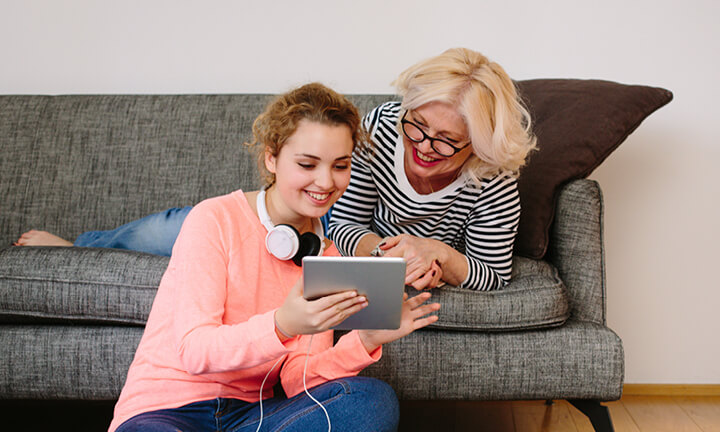It’s back-to-school time again and the need for your child’s healthy eyes and good vision remains just as important for learning. So, as you prepare to start the school year, consider getting your kids an eye exam before classes start.
1) When does my child’s vision stop developing?
After your child is born, their eyes continue to develop, change, and mature until around the age of four to six years old. During that time, there are lots of important developmental stages that their eyes pass through, and at these precious junctures, eyesight is constantly changing and evolving. Generally, these milestones occur with steady, proper development of your child’s vision, but sometimes these changes lead to vision impairment or even expose other fundamental eye problems.
2) Does my child need to get an eye exam?
Yes, your child should get an eye exam, and as much as you have your child’s best interests at heart, the truth is, you may not always know or notice that they have a vision problem. In fact, only 63.5% of children aged 3-5 across the country have received any kind of vision screening. This helps explain why about 1 in 4 children have undetected vision problems, and why your child may also be at risk for undetected vision impairment.
While there are some signs to help inform you that your child has vision problems, an eye exam is the best way to detect, diagnose, and correct vision issues. If vision problems are detected early on — especially before the age of seven — then permanent vision correction will be much more effective.
3) What are the effects of undetected vision impairment on your child’s development?
Children use their eyes for almost everything they do. They use vision for engagement in sports, playing with others, and learning activities, like reading. It is one of the body’s most important senses and delivers constant information to the brain.
When your child has an undetected vision impairment problem, their ability to engage in the classroom, on the playground, and with their teachers and peers is also impaired. For example, if your child has trouble reading the whiteboard or catching the kickball as well as their classmates — then their short-term confidence and self-esteem may be diminished. On a longer timeline, this can lead to developmental, learning, and social adjustment problems.
Because untreated vision problems in children can look like behavioral problems like attention deficit hyperactivity disorder (ADHD), children may get misdiagnosed. As such, the CDC recommends that every child receives at least one comprehensive dilated eye exam between the ages of three and five, and annually thereafter.
4) What is the difference between a child’s vision screening and a comprehensive eye exam
A vision screening administered by schools or during your child’s annual well visit is a good start towards identifying potential vision problems. However, these screenings will not diagnose eye diseases or provide options for correcting your child’s vision, if that is necessary. Only a comprehensive eye exam and consultation with an eye doctor can do this. See the different eye health items checked in a vision screening versus a comprehensive eye exam:
- A vision screening checks for the following:
-
- Visual acuity
- Eyes working together
- Basic eye health
- A comprehensive eye exam tests for the following:
-
- Visual acuity
- Eyes working together
- Basic eye health
- Chronic diseases
- Color vision
- Diagnosis
- Treatment
- Most common vision problems for children
In school-aged children, these five conditions are most commonly diagnosed and treated by optometrists:
-
- Amblyopia — lazy eye
- Myopia — nearsightedness
- Hyperopia — farsightedness
- Astigmatism — abnormal lens shape
- Exotropia and convergence insufficiency — weakened eye muscles
Refractive errors are relatively easy to correct with prescription glasses or contact lenses, but your eye doctor may also be able to provide potential solutions for more severe eye problems your child might have.
5) What are some signs that your child may have a vision problem?
It’s important for parents to be able to identify if their child has vision problems, so you’ll want to be on the lookout for these behaviors which may indicate a vision problem:
- Sits close to the television or computer screen
- Holds books very close to their face
- Rubs eyes often
- Squints or tilts head
- Loses place while reading
- Sensitive to light and light changes
If your child is showing these types of behaviors, be sure to schedule an appointment with your eye doctor or health care professional.
6) How to introduce your child to their prescription eyeglasses.
Following their eye exam, if any vision problems were discovered, your child may receive a prescription for a new pair of eyeglasses. The eye doctor will likely help you explain to your child how often they need to wear the glasses and in which situations. Beyond that, it will be up to you to help your child to take care of their glasses, and to use them properly for optimal vision correction.
For starters, you might consider a warranty that covers replacement of frames and lenses for your child’s first pair. Children’s glasses are more prone to damage, especially while your son or daughter gets adjusted to having them on their face. It’s simply part of the process — and the active nature of kids!
Second, to avoid some of the accidents associated with the adjustment phase, ask the optician about impact-resistant polycarbonate lenses, spring hinges that hold the glasses in place, and adjustable nose pads for proper bridge fit. These can protect your child’s eyes from shattered lenses and save you from multiple trips to the optical store to replace broken frames.
Finally, show your child multiple times exactly how to clean and store their glasses. Here are a few tips to help clean and store your eyeglasses:
- Always use a microfiber cloth for lens cleaning, since other materials might scratch the lenses unintentionally.
- Pre-wetted disposable lens cloths are available for purchase and make keeping lenses clean a breeze for children.
- Always place their glasses in the case after they take them off.
- It’s a good idea to purchase a second pair and multiple cases and put them in the most convenient places so your child doesn’t forget. Examples include their backpack, desk at home, bathroom, and so on.
Giving your child an extra good start this school year is easy. Use your eye care insurance today to get your child the check-up they need.
It’s easy to get vision insurance coverage for your entire family by adding multiple people to your VSP® Individual Vision Plan. That means your children will also be eligible for an annual comprehensive eye exam, at no additional cost to you. If you don’t have vision insurance, find out how VSP Individual Vision Plans can help you save on your next eye exam or pair of glasses.
Information received through VSP Individual Vision Plans’ social media channels is for informational purposes only and does not constitute medical advice, medical recommendations, diagnosis or treatment. Always seek the advice of your physician or other qualified health provider with any questions you may have regarding a medical condition.
Your vision. Your way.
Not covered for vision? Get an individual plan, customized for you – including where you want to use it: at the doctor, in a retail location, or even online.

Summer Eye Health: Questions and Answers for Healthy Vision
Summer is a time for fun in the sun! Summer is also a season when your eyes may need extra attention. June is Healthy Vision Month, a great time to ...

When Is the Best Time to Get Vision Insurance?
When looking for a vision insurance plan, ideally you’d be able to enroll in vision insurance whenever you need it. After all, our eyes are a ...

How Much Does an Eye Exam Cost?
Eye exams are an essential part of maintaining your overall health and wellness, yet many people neglect them due to the costs involved. The price o...

